Minor chord progressions are the backbone of countless emotional and evocative songs that have captivated listeners throughout the years.
As a fellow music producer, I understand the importance of understanding the power of these progressions to create memorable and moving music.
In this comprehensive guide, we’ll delve into the fascinating world of minor chords, their impact, and how they can elevate your music production.
Here’s a breakdown of what we’ll cover:
- The emotional impact of minor scale chord progressions ✓
- Different types of minor scales ✓
- Essential minor chords and their roles in progressions ✓
- Roman numerals ✓
- Tips & techniques for crafting your own captivating minor chord progressions ✓
- Popular minor chord progressions in modern music ✓
- Incorporating major chords and keys into your minor progressions ✓
Get ready to explore the world of minor chord progressions.
Let’s dive in…
Table of Contents
- What Are Minor Chords?
- Difference Between Major and Minor Chords
- Scales: Understanding the Building Blocks
- Essential Minor Chords
- Understanding Roman Numerals
- Common Minor Chord Progressions
- Building Your Own Minor Chords
- 5 Examples of Popular Songs with Minor Chord Progressions
- Tips & Techniques for Building Minor Chord Progressions
- Major Chords Within Minor Progressions
- Exploring vi-iii-vii Progressions
- E Minor: A Powerful and Popular Key
- Mixing Major & Minor Keys
- Bonus: Understanding Leading Tones
- Minor Chord Progressions: Final Thoughts
What Are Minor Chords?
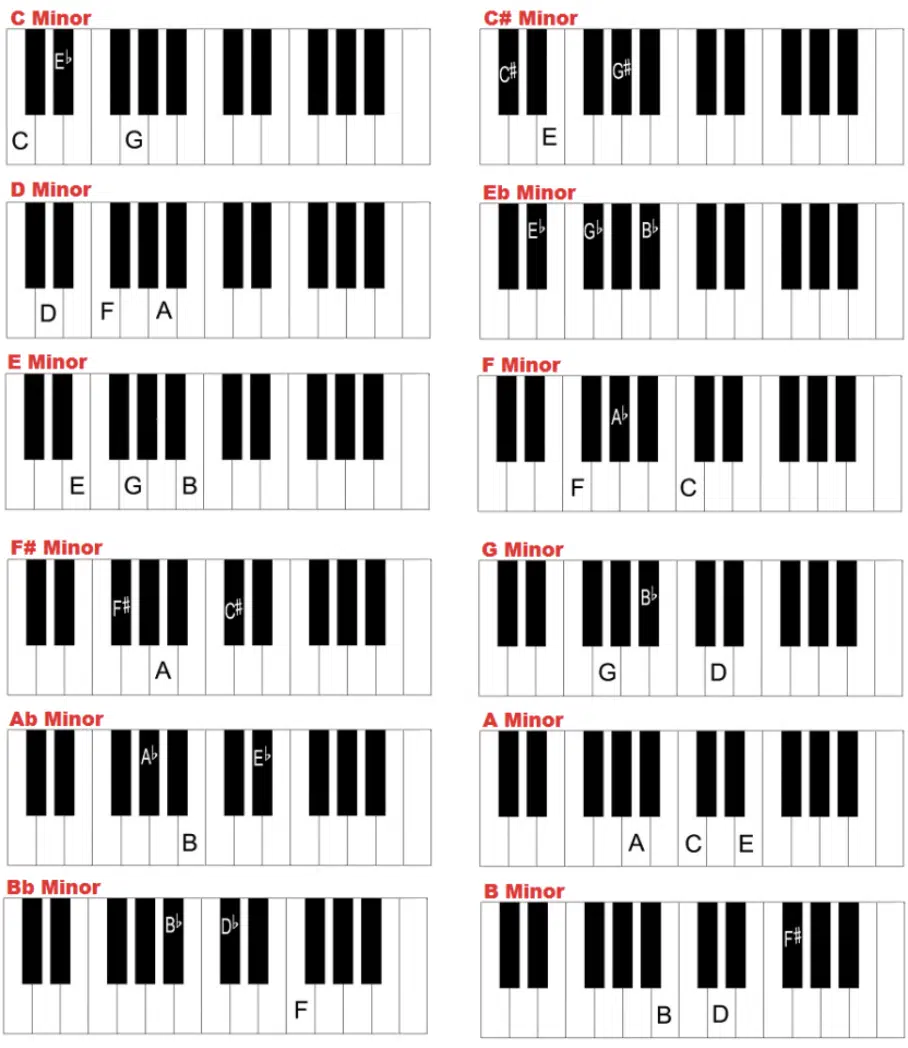
Minor chord progressions have a unique ability to evoke deep emotions, often associated with sadness, melancholy, or mystery.
This is due to the intervals between the notes in minor chords, which create a sense of tension and resolution.
When used effectively, minor chord progressions can add a layer of depth and emotion to your music that listeners will find captivating.
The emotional impact of minor chords can also vary depending on the specific minor chord progression you choose.
Some minor progressions can sound more somber and introspective, while others might have a more uplifting or hopeful quality.
By experimenting with different minor chord progressions, you can find the perfect combination of chords to evoke the specific emotion you want to convey in your music.
It’s essential to understand that the emotional power of minor chord progressions isn’t limited to just sad or melancholic music.
You can also use minor progressions to create tension, excitement, or even a sense of mystery in your music.
The key is to understand the underlying emotional qualities of different minor chord progressions and use them to your advantage in your compositions.
Difference Between Major and Minor Chords
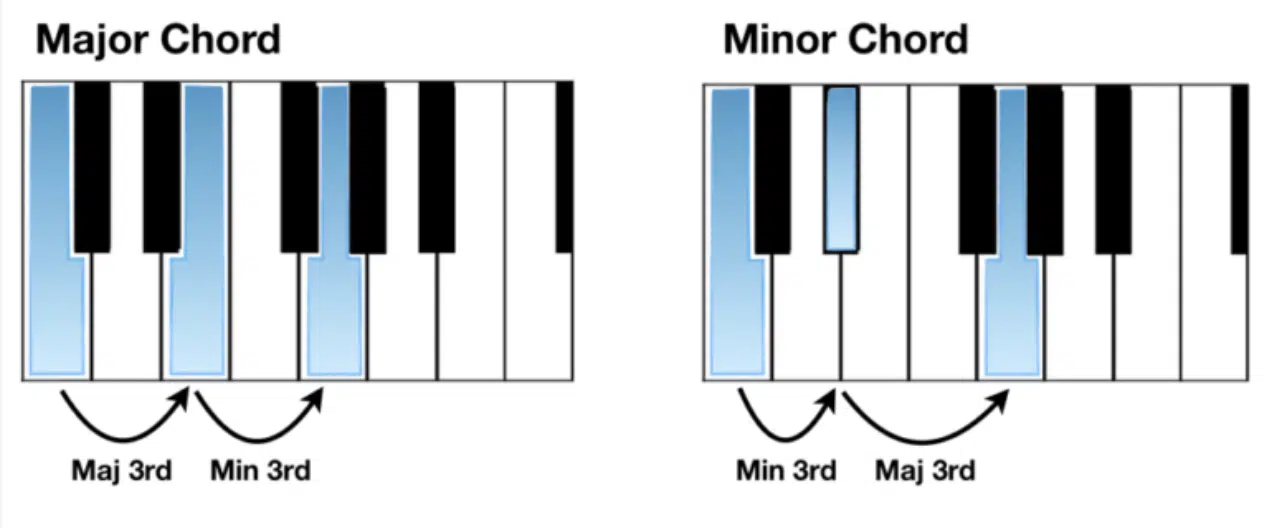
The difference between major and minor chords lies in the third note of the chord.
- In a major chord 一 The third note is a major third interval above the root note.
- In a minor chord 一 The third note is a minor third interval above the root note.
This seemingly small difference in intervals has a significant impact on the overall sound and emotional quality of the chord.
Major chords generally have a more upbeat, happy, and bright sound, while minor chords have a darker, sadder, and more introspective quality.
This contrast between minor and major chords is one of the essential foundations of Western music.
As a music producer, it’s important to understand and be able to utilize both types of chords effectively.
To further understand this concept, let’s take a look at the C major and C minor chords.
The C major chord consists of the notes C, E, and G, while the C minor chord contains the notes C, E♭, and G.
The only difference between these two chords is the E♭ in the C minor chord, which gives the chord its distinctively darker and sadder quality.
Scales: Understanding the Building Blocks
-
Natural Minor Scale

The natural minor scale is one of the three main types of minor scales and is often the first type of minor scale that musicians learn.
This scale is derived from the major scale and has a distinct sound that can be described as dark, moody, or melancholic.
To construct a natural minor scale, you can start with a major scale and lower the third, sixth, and seventh notes by a half step.
For example, to create an A natural minor scale, you would start with the A major scale (A, B, C#, D, E, F#, G#) and lower the third (C#), sixth (F#), and seventh (G#) notes by a half step.
Understanding the natural minor is essential for creating chord progressions because it provides the foundation for building minor chords.
Plus, it helps you understand how chords relate to one another within a minor key.
-
Harmonic Minor Scale
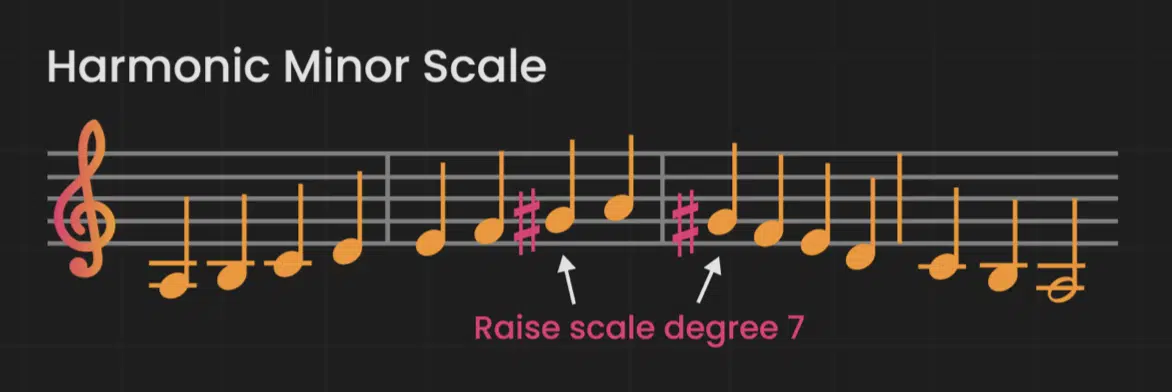
This type of minor scale is another important one that is commonly used in music and sad songs.
This scale is similar to the natural minor but features a raised seventh note, which creates a stronger sense of tension and resolution within the scale.
To construct this type of minor scale, you can start with a natural minor scale and raise the seventh note by a half step.
For example, to create an A harmonic minor scale, you would start with the A natural minor scale (A, B, C, D, E, F, G) and raise the seventh note (G) by a half step.
The harmonic minor scale is particularly useful for creating minor progressions that have a strong sense of tension and resolution.
As well as for creating more exotic-sounding melodies and harmonies.
-
Melodic Minor Scale
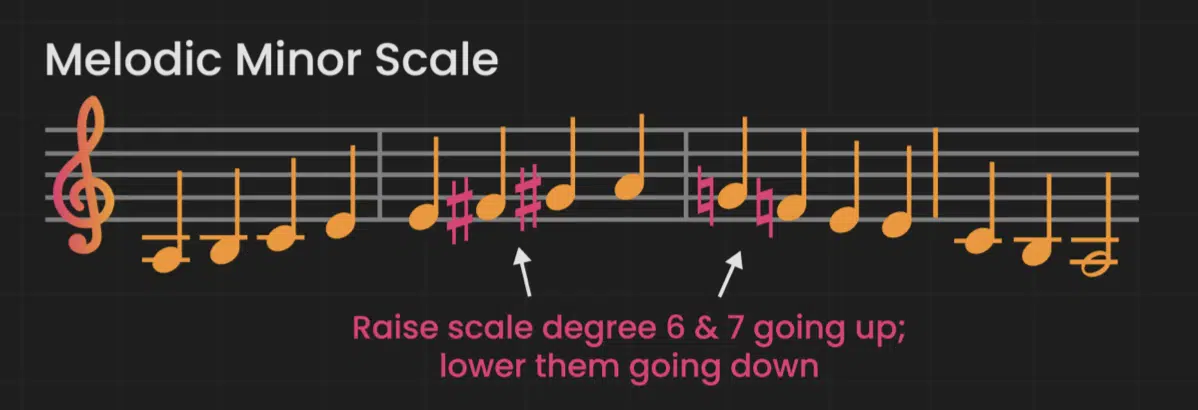
The melodic minor scale is the third main type of minor scale and is characterized by its unique ascending and descending forms.
When ascending, the melodic minor scale features a raised sixth and seventh note, while the descending form reverts to the natural minor scale.
To construct a melodic minor scale, you can start with a natural minor scale and raise the sixth and seventh notes by a half step when ascending 一 use the natural minor scale when descending.
For example, to create an A melodic minor scale, you would start with the A natural minor scale (A, B, C, D, E, F, G) and raise the sixth (F) and seventh (G) notes by a half step when ascending.
This results in the A melodic minor scale ascending (A, B, C, D, E, F#, G#) and the A natural minor scale descending (A, B, C, D, E, F, G).
The melodic minor scale is often used in jazz and classical music to create interesting and varied melodies and harmonies.
Understanding the melodic minor scale can help you create minor progressions with a more nuanced and dynamic quality.
Essential Minor Chords
Being familiar with the most essential minor chords is key to creating deeply moving progressions.
-
The i Chord

The i chord is the first chord in a minor key and serves as the tonal center for the key.
It’s composed of:
- The root note
- A minor third
- A perfect fifth
In the key of A minor, for example, the i chord would be A, C, and E (A minor).
This chord provides a strong sense of resolution and stability within a minor progression.
Speaking of progressions, if you’d like to know how to create chord progressions like Pop Smoke, we made an entire video about it.
-
The iv Chord

The iv chord is the fourth chord in a minor key and is also a minor chord.
It’s made up of:
- The fourth scale degree
- A minor third above that
- A perfect fifth above the root note
In the key of A minor, the iv chord would be D, F, and A (D minor).
This chord often serves as a transition between the i and v chords, providing a sense of movement and anticipation.
-
The v chord

The v chord is the fifth chord in a minor key and is usually a minor chord.
It consists of:
- The fifth scale degree
- A minor third above that
- A perfect fifth above the root note
In the key of A minor, the v chord would be E, G, and B (E minor).
The v chord creates tension that is resolved when it moves back to the i chord, making it a crucial element in many minor key songs.
Speaking of songs, if you want to create a killer song from scratch, then check out our article all about how to write a song.
-
vi chord

The vi chord is the sixth chord in a minor key and is typically a major chord.
It’s built from:
- The sixth scale degree
- A major third above that
- A perfect fifth above the root note
In the key of A minor, the vi chord would be F, A, and C (F major).
The vi chord can provide a sense of contrast and relief within a minor chord progression, adding an element of surprise and intrigue.
Understanding Roman Numerals
Roman numerals are used to represent chords within a key, making it easier to understand and create chord progressions.
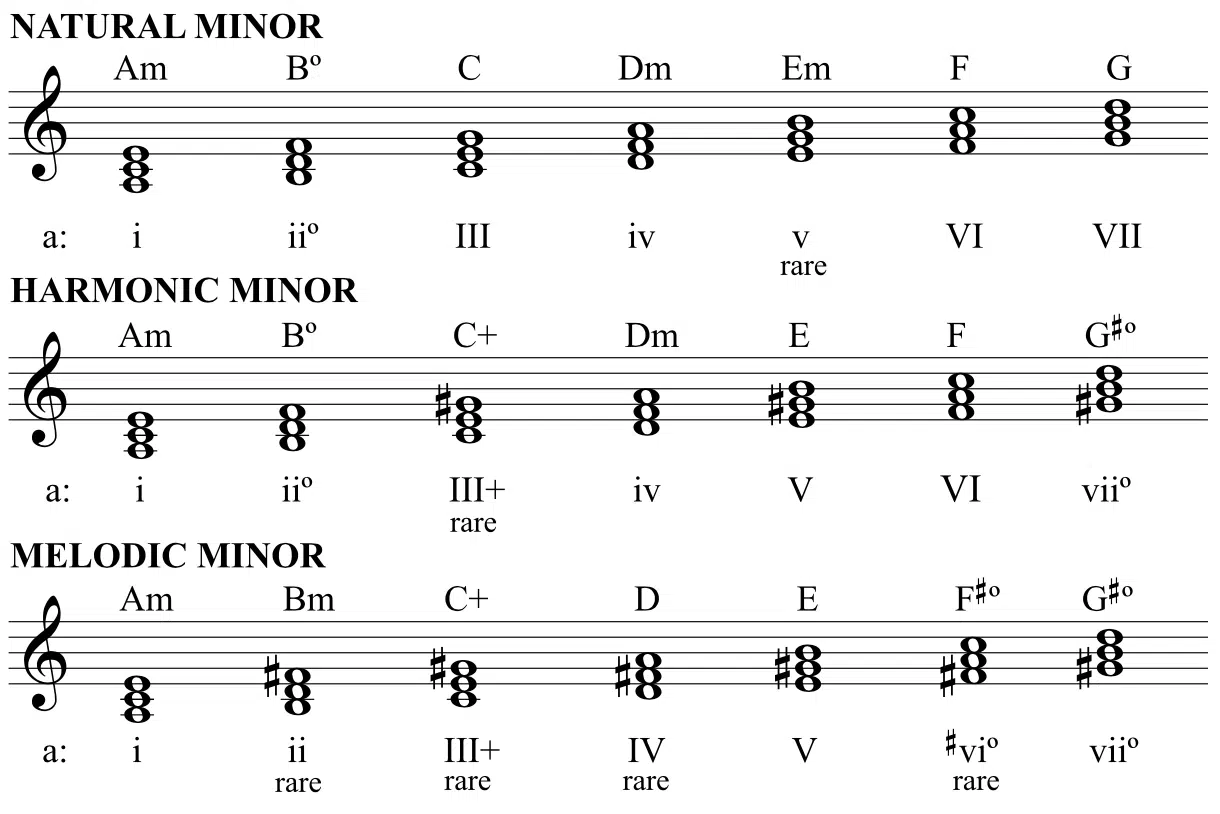
In this system, each chord is represented by a Roman numeral that corresponds to its position within the key’s scale.
In minor keys, the Roman numerals are as follows: i, ii°, III, iv, v, VI, and VII.
- Lowercase Roman numerals 一 Represent minor chords.
- Uppercase Roman numerals 一 Represent major chords.
The degree symbol (°) next to the ii chord indicates that it is a diminished chord.
By understanding Roman numeral notation, you can quickly identify the chords within a minor key and create chord progressions by combining different Roman numerals.
Big artists like Kendrick Lamar and Marshmello use this method all the time for their hip hop chord progressions.
Creating Minor Progressions with Roman Numerals
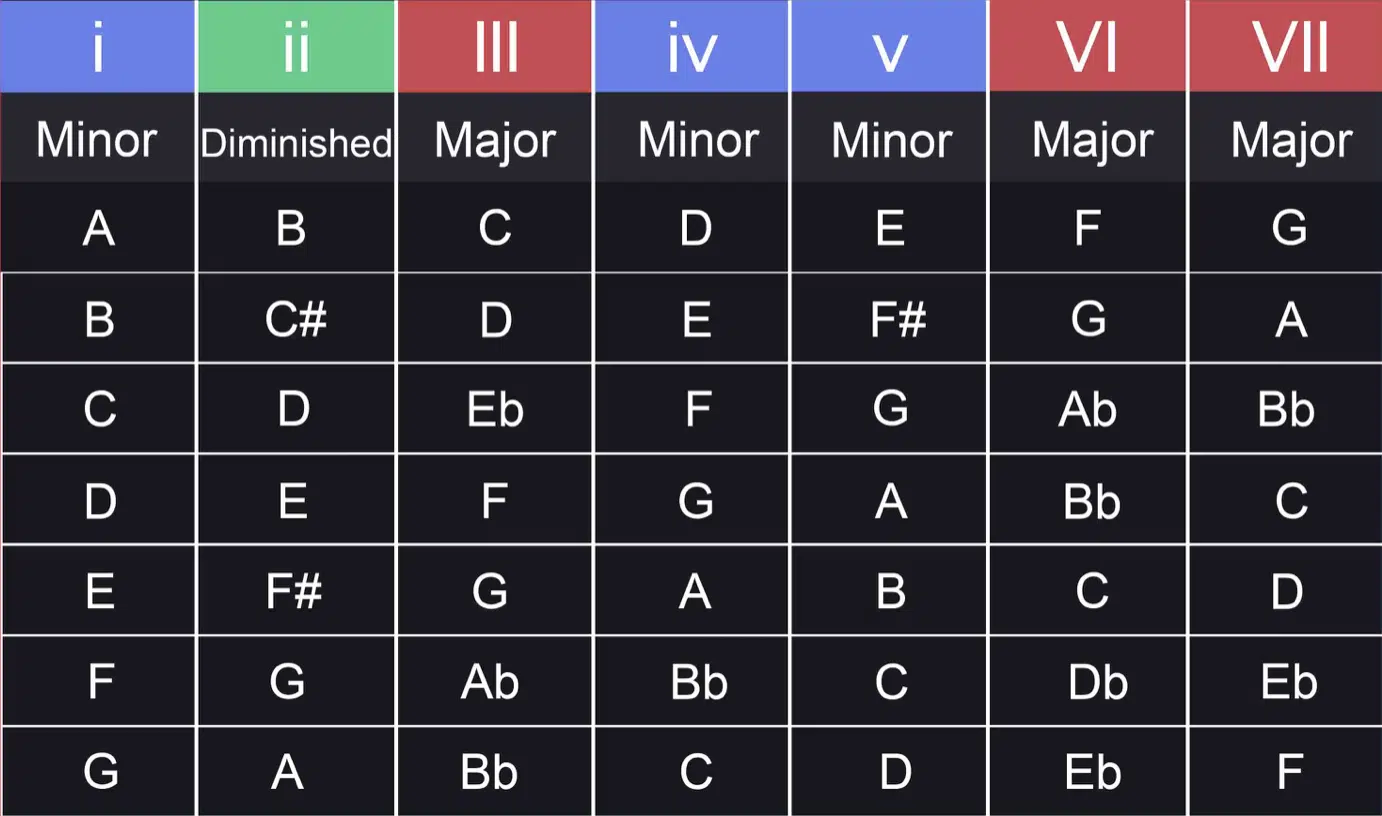
Once you have a grasp on Roman numeral notation, you can start creating minor progressions by combining different Roman numerals.
For example, a common minor chord progression is the i-iv-v progression, which, as mentioned earlier, uses the first (i), fourth (iv), and fifth (v) chords in a minor key.
Using Roman numerals allows you to easily transpose your chord progressions to different minor keys.
If you have a chord progression in the key of A minor and want to transpose it to E minor, you can simply use the same Roman numerals and apply them to the E minor scale.
This versatility and ease of transposition make Roman numeral notation an invaluable tool for creating captivating minor progressions that can be easily adapted to different musical situations.
Common Minor Chord Progressions
There are several common chord progressions in minor that can be found in countless songs across various genres, including hip hop subgenres.
These popular chord progressions often serve as the foundation for creating captivating and emotional music in a minor key.
The i-iv-v progression

The i-iv-v progression is a classic minor chord progression often found in blues and rock music.
It evokes a sense of longing and introspection.
In the key of A minor, this progression would consist of the chords Am (i), Dm (iv), and Em (v).
A modern example of the i-iv-v progression can be found in the song “Hurt” by Nine Inch Nails, famously covered by Johnny Cash.
The verse sections of this song employ this progression, creating a somber and emotional atmosphere.
The i-VI-III-VII progression

A common minor chord progression that you’ll often encounter is the i-VI-III-VII progression.
This progression can evoke a sense of mystery and sadness, making it a popular choice for many composers.
In the key of A minor, this progression would consist of the chords Am (i), F (VI), C (III), and G (VII).
A popular example of the i-VI-III-VII progression is “Radioactive” by Imagine Dragons.
The verse and chorus sections of this song feature this progression, contributing to its intense and powerful sound.
The i-iv-V-i progression
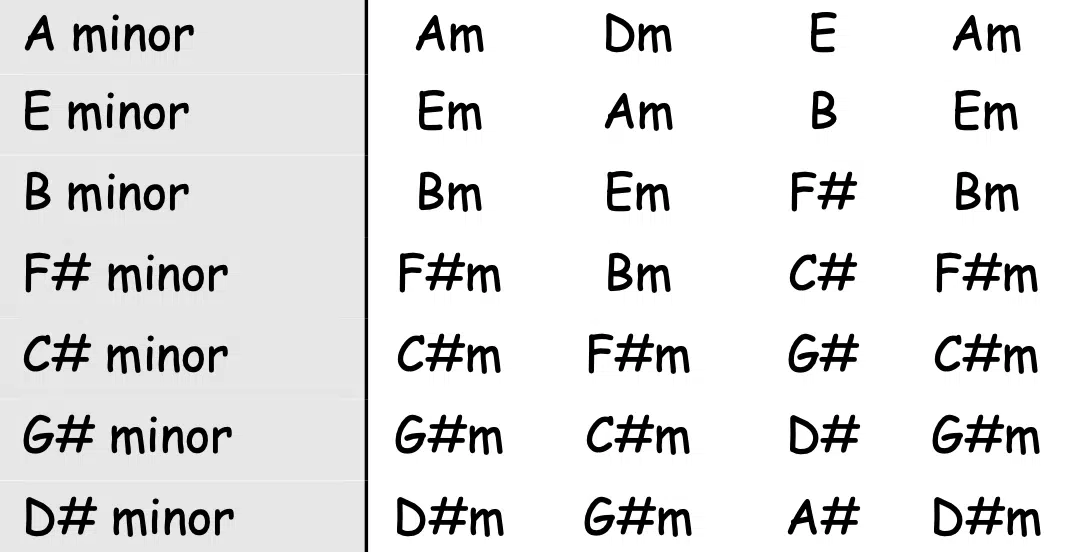
The i-iv-V-i progression is another popular chord progression that adds a resolution back to the tonic (i) chord after the v chord.
This progression is often used in pop and rock music for its emotional impact.
In the key of A minor, this progression would consist of the chords Am (i), Dm (iv), E (V), and Am (i) again.
A well-known song that uses the i-iv-V-i progression is “Bad Guy” by Billie Eilish.
The verse sections of the song feature a variation of this progression, giving the track a distinctive and eerie vibe.
The iv-i-V progression

The iv-i-V progression is another common minor chord progression that is particularly effective in creating a sense of anticipation and release.
In the key of A minor, this progression would consist of the chords Dm (iv), Am (i), and E (V).
An example of the iv-i-V progression can be found in the song “Take Me to Church” by Hozier.
The verse sections of this song use this progression, adding to the song’s dramatic, soulful, impactful tone.
Building Your Own Minor Chords
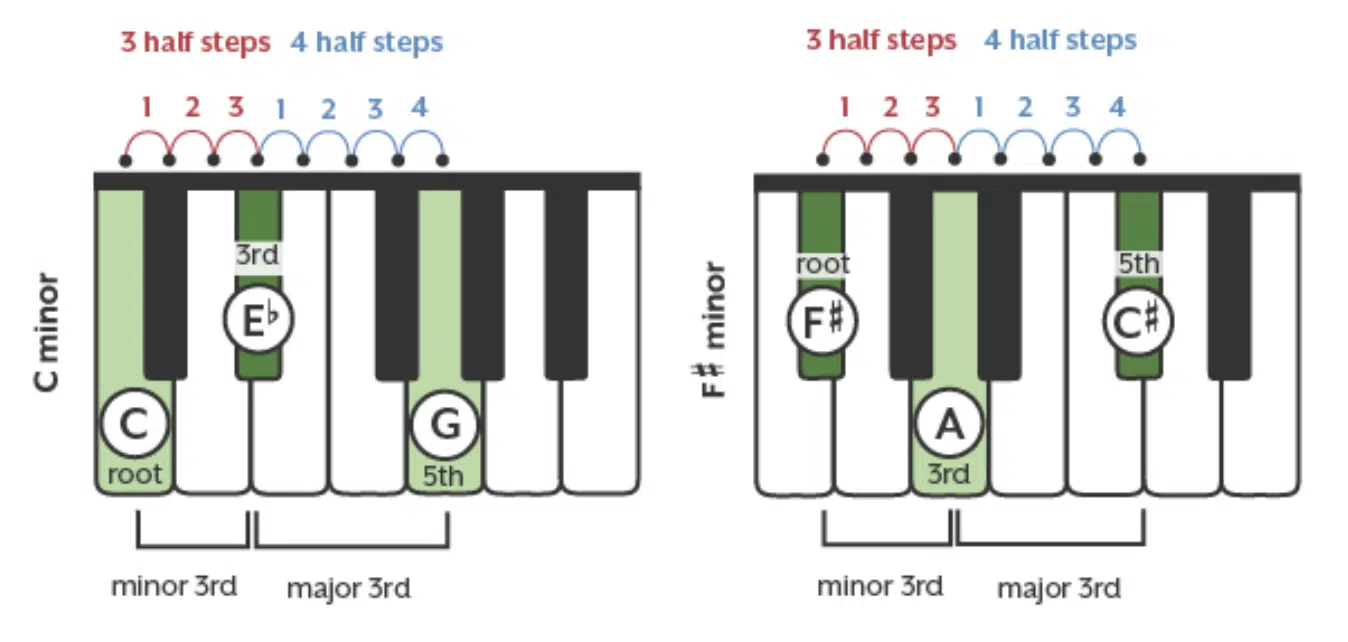
To create minor chords, you need to understand the concept of intervals, specifically the minor third and perfect fifth intervals.
A minor chord consists of:
- A root note
- A minor third interval above the root
- A perfect fifth interval above the root
The minor third interval is what gives the chord its characteristic “sad” or “dark” sound.
To build a minor chord, start with the root note and count up three semitones (half steps) to find the minor third.
Then, count up seven semitones (half steps) from the root to find the perfect fifth.
These three notes together form a minor chord.
Let’s take a look at building a C minor chord as an example.
- Start with the root note: C
- The minor third interval above C is: E♭
- The perfect fifth interval above C is: G
Therefore, a C minor consists of the notes C, E♭, and G.
Building minor chords can be done for any note in a minor scale, allowing you to create a series of chords that can be used to form minor progressions.
Once you’ve mastered the basic structure of minor chords, you can create chords with different voicings and inversions to add variety and depth to your chord progressions.

Voicings refer to the arrangement of notes within a chord, while inversions involve changing the order of the notes, with a note other than the root in the bass.
For example, on a keyboard, you could try playing the A minor chord with the C note as the lowest pitch, creating the first inversion (C-E-A).
Speaking of pitch and bass, if you’re looking for the best pitch shifter plugins or the first AI bass generator ever, look no further.
5 Examples of Popular Songs with Minor Chord Progressions
Understanding music theory can open up a world of possibilities for any music producer, especially when it comes to analyzing popular songs.
If you need a refresher course, or just want to excel in your knowledge of Music Theory, we got your back.
To give you an idea of how these chord progressions have been used in recent hit songs, let’s take a look at 5 popular examples:
-
“Shape of You” by Ed Sheeran
Ed Sheeran’s chart-topping hit “Shape of You” features a catchy i-III-iv-iv progression in the key of C♯ minor.
The combination of the infectious melody and rhythm, along with the minor chord progression, helped make this song a massive success and a staple in modern pop music.
-
“Bad Guy” by Billie Eilish
“Bad Guy” features a distinctive i-iv-v-i progression that gives the song its eerie and menacing vibe.
This progression helps create an unforgettable sound that has captured the attention of listeners worldwide.
-
“Blinding Lights” by The Weeknd
In “Blinding Lights,” The Weeknd uses an i-VI-III-VII progression in the key of E♭ minor.
The driving synth lines and catchy melody work together with this minor chord progression, creating an 80s-inspired sound that has resonated with a wide audience.
-
“Without Me” by Halsey
Halsey’s hit song “Without Me” is based on an i-VI-III-VII progression in the key of D♭ minor.
The moody and introspective nature of the progression complements the deeply personal lyrics, showcasing the versatility of minor chord progressions in contemporary pop music.
These examples demonstrate how a solid understanding of music theory and minor progressions can help you create powerful and memorable beats that resonate with listeners.
-
“Royals” by Lorde
Lorde’s breakthrough hit “Royals” employs an i-v-III-III progression in the key of D minor.
This song’s minimalist production and the use of minor chords create a moody atmosphere that complements the lyrics, which critique materialism and wealth.
The distinctive sound and relatable message have made “Royals” an enduring favorite among listeners.
Tips & Techniques for Building Minor Chord Progressions
Now that you’re familiar with the basics, here are some tips & techniques for building your very own minor chord progressions.
-
Experimenting with Chord Inversions

Chord inversions are a technique that involves changing the order of the notes in a chord, which can add interest and variety to your basic chord progression.
By using inversions, you can create smoother transitions between chords and achieve different voicings that give your music a unique sound.
To create an inversion, you can move the lowest note of a chord up an octave or the highest note down an octave.
For example, the root position of an A minor chord is A, C, and E.
- The first inversion 一 Would be C, E, and A (with the C now as the lowest note).
- The second inversion 一 Would be E, A, and C (with the E as the lowest note).
Experimenting with different chord inversions can help you discover new harmonic possibilities.
Plus, create minor chord progressions that sound fresh, engaging, and far from basic.
-
Borrowing Chords from Parallel Major and Minor Keys
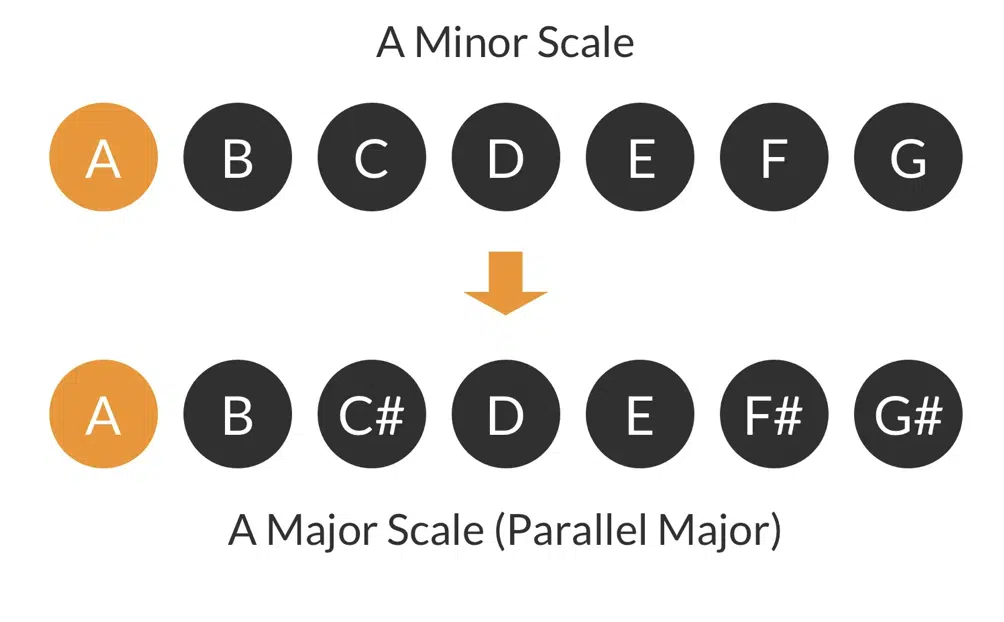
Chord borrowing is a technique that involves using chords from a parallel major or minor key in your minor chord progressions.
This can add unexpected harmonic twists and create a more complex, rich sound.
For instance, if you’re working in the key of A minor, the parallel major key is A major.
You could borrow chords from the A major key, such as the A major chord itself, and incorporate it into your minor chord progression to create a sense of mystery and intrigue.
Don’t be afraid to play around with borrowing chords from parallel minor and major keys.
This can open up new possibilities for your minor chord progressions and help you create music that is more dynamic and engaging.
-
Combining Different Types of Minor Scales
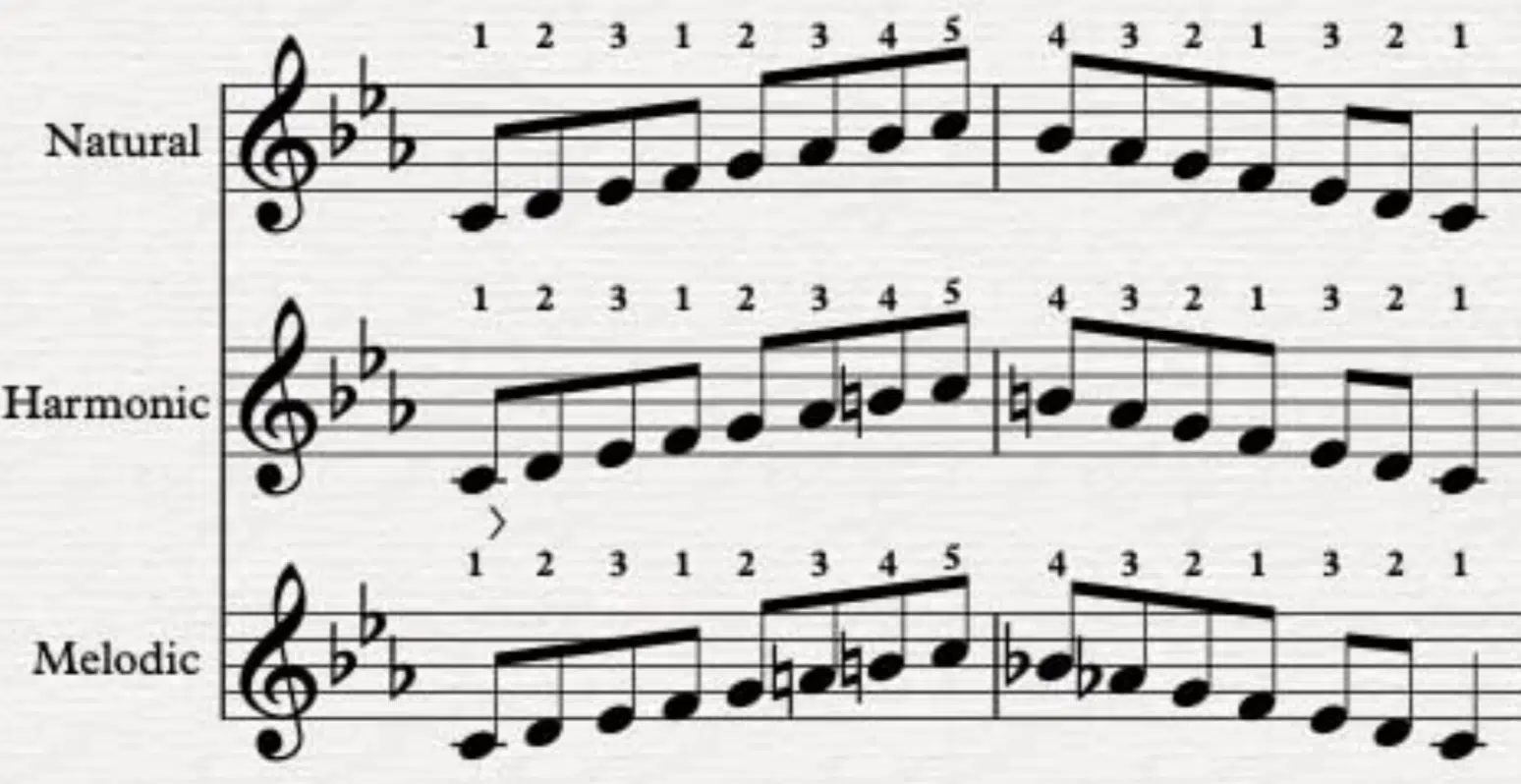
Another technique for crafting unique minor chord progressions is to combine chords from different types of minor scales, such as the natural, harmonic, and melodic minor scales.
This can create interesting harmonic textures and add depth to your music.
You might create a chord progression in A minor using chords from the A natural minor scale, then introduce a chord from the A harmonic scale (minor) for added tension and drama.
Experimenting with chords from different minor scales can help you uncover new harmonic ideas.
Plus, it gives your minor progressions a more nuanced, intriguing sound.
Side note, if you’re unsure of the minor scales and major scales, we break them down and explain all the different moving parts.
Major Chords Within Minor Progressions
Major chords can be found in minor keys, usually as the III, VI, or VII chords.
These chords can add interest and variety to a minor chord progression, creating moments of brightness and tension.
In the key of A minor, the III chord would be C major, the VI chord would be F major, and the VII chord would be G major.
-
Major iv chord
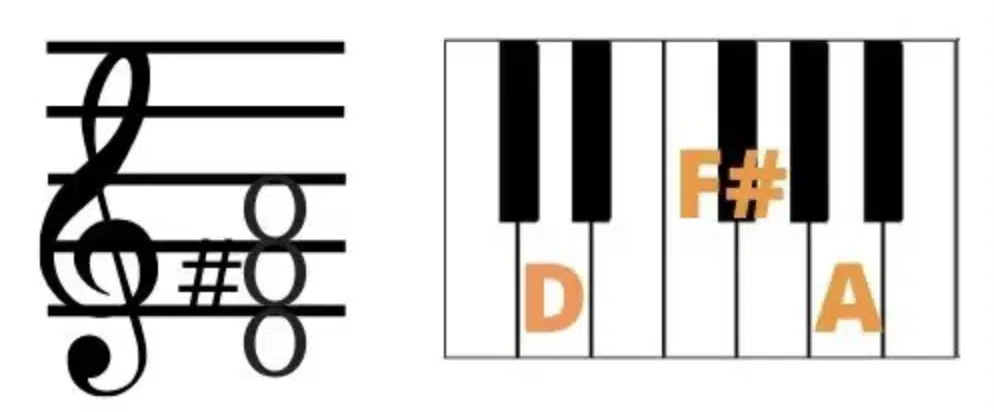
Occasionally, a major iv chord can be used within a minor chord progression to add a sense of tension and surprise.
This involves raising the minor third of the iv chord to a major third.
In the key of A minor, the major iv chord would be D, F#, and A (D major).
This chord can create an unexpected twist in your minor chord progression, which can help blow your audience away and make them feel your music on a whole different level.
-
Major Chord Progressions
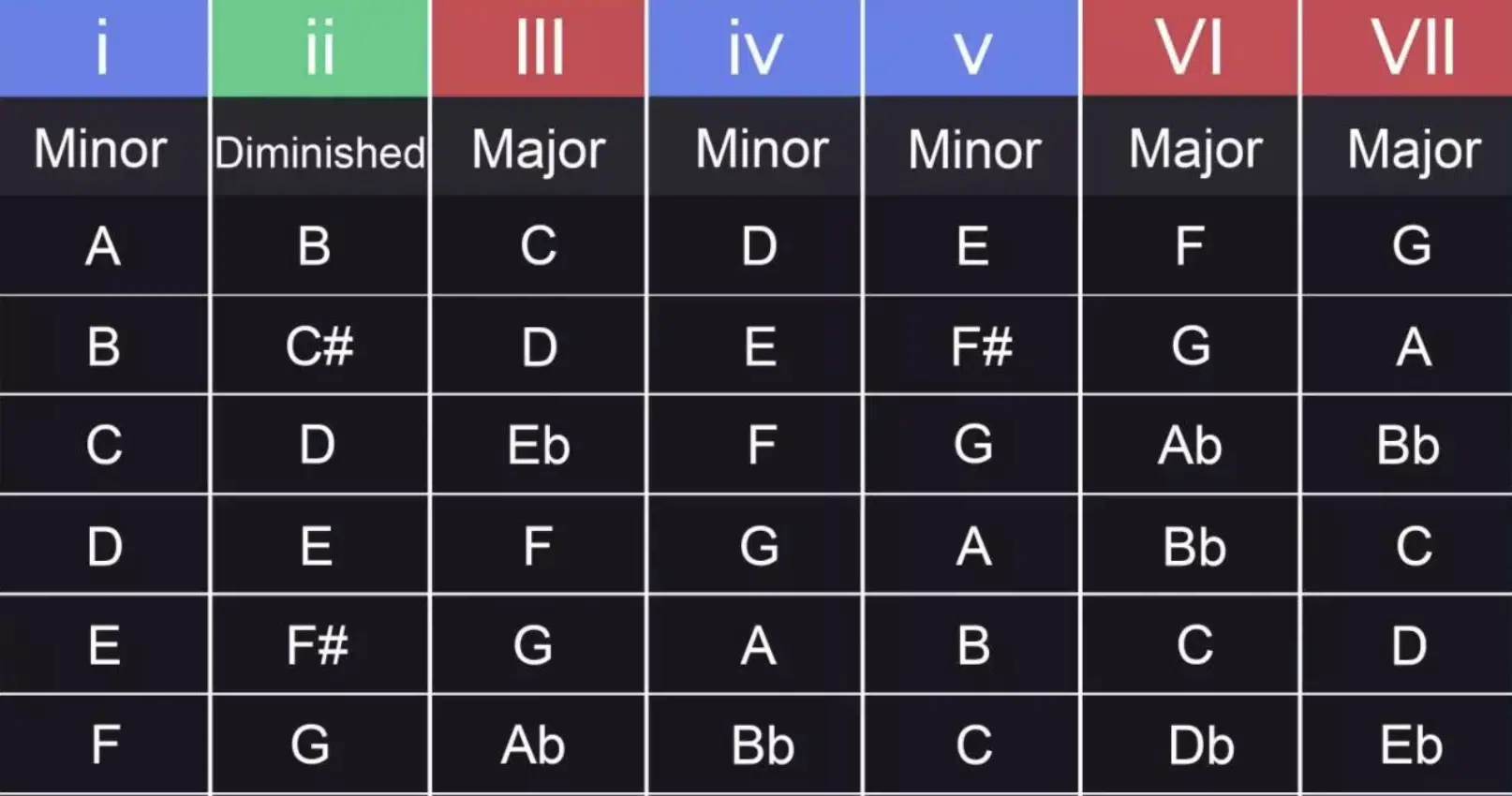
Major chord progressions can also be used within a minor key, often as borrowed chords from the parallel major key.
This uses Music Theory to create a sense of contrast and add harmonic richness to your music.
In the key of A minor, for example, you could borrow chords from the parallel key of A major, such as the I, IV, and V chords (A major, D major, and E major).
Exploring vi-iii-vii Progressions

The vi-iii-vii progression is a captivating and emotional chord progression that can be found in many songs across various genres.
It typically involves the sixth (vi), third (iii), and seventh (vii) chords in a minor key.
This progression has a strong sense of movement and drama, often evoking feelings of longing, sadness, and introspection.
It can be an effective choice when you want to create a deeply emotional and powerful musical moment.
There are numerous examples of the vi-iii-vii progression in popular music, showcasing its versatility and emotional impact.
Some of these examples include Radiohead’s “Exit Music (For a Film),” The Beatles’ “While My Guitar Gently Weeps,” and Adele’s “Hello.”
By studying these songs and others that feature the vi-iii-vii progression, you can gain a better understanding of how to use it effectively in your own music and create compelling minor chord progressions.
E Minor: A Powerful and Popular Key

E Minor is a popular key for many musicians, known for its dark, powerful, and emotive qualities.
The key consists of the notes E, F#, G, A, B, C, and D, with the E minor chord (E, G, B) serving as the tonal center.
The key of E Minor can evoke a range of emotions, from melancholy and introspection to intensity and passion, making it a versatile choice for all vibes and styles.
Examples of songs in E Minor

There are countless songs written in the key of E Minor, showcasing its emotional depth and appeal.
Some notable examples of E minor key chord progressions include Nirvana’s “Come As You Are,” Led Zeppelin’s “Stairway to Heaven,” and Billie Eilish’s “Bury a Friend.”
By studying these songs and others in E Minor, you can gain a better understanding of the key’s unique qualities and learn how to harness its power in your own minor chord progressions.
Mixing Major & Minor Keys
Major and minor keys are related through their relative and parallel relationships.
The relative minor key shares the same key signature as its major counterpart, while the parallel minor key has the same root note but a different key signature.
Understanding the relationship between major and minor keys can open up new possibilities for blending these two tonalities in your chord progressions.
This will help you produce music that is more diverse and emotionally jam-packed.
Since we keep mentioning the word “parallel,” I would be remiss not to mention our extensive article all about parallel processing.
How To Incorporate Major Keys Into Your Minor Chord Progression
One way to incorporate major keys into minor chord progressions is by borrowing chords from the parallel major key, which can create moments of brightness and surprise within the progression.
Another approach is to use the relative major key as a point of contrast, transitioning between the minor and major tonalities.
This will evoke a range of emotions and create a more enjoyable (and addictive) listening experience.
Bonus: Understanding Leading Tones
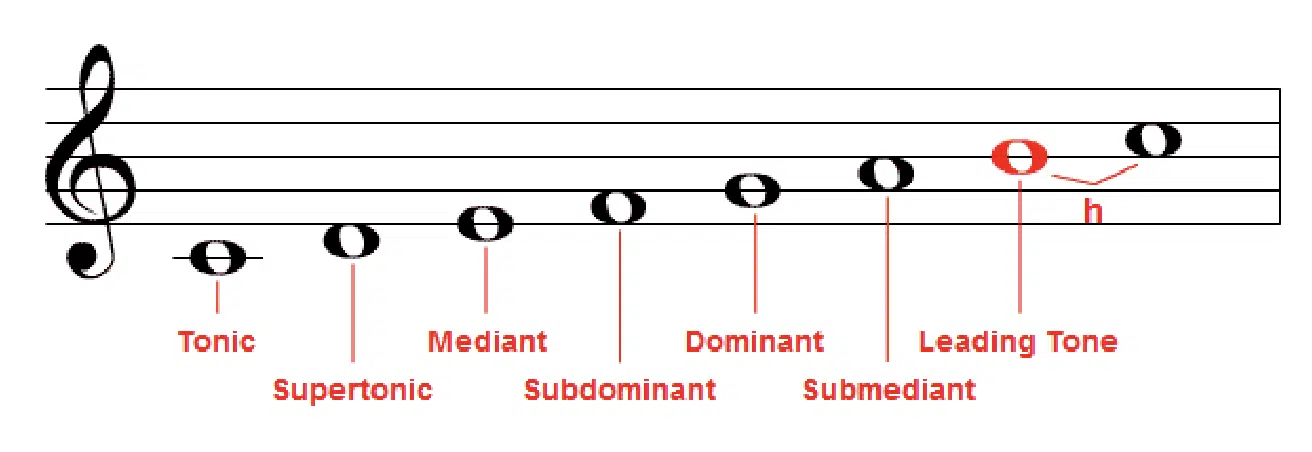
A leading tone is the seventh scale degree of a major or harmonic minor scale 一 which is a half step below the tonic (root) note.
Leading tones create a sense of tension that is resolved when they move to the tonic note.
In a minor key, the leading tone is particularly important for creating tension and drama within chord progressions, often used in conjunction with the V or vii° chords.
Leading tones play a crucial role in establishing tension and resolution within minor chord progressions.
They can help to create a sense of momentum and anticipation, leading the listener to expect a resolution back to the tonic (i) chord.
By incorporating leading tones into your minor chord progressions, you can add depth and intensity to your music, creating a more engaging and dramatic final product.
Minor Chord Progressions: Final Thoughts
As we reach the end of our journey through minor chord progressions, you’re now equipped with the knowledge and techniques to create your very own mind-blowing masterpieces.
Playing around with different progressions, blending major and minor keys, and harnessing the emotional power of minor chords will help you craft unforgettable (and addicting) tracks.
To further elevate your music production skills, you’ve got to check out these beautifully crafted free Advanced MIDI Chord Progressions.
They will empower you to produce captivating and alluring progressions that resonate with your listeners and leave a lasting impression.
Plus, when you use them, you’ll set yourself apart from 99% of producers who just have access to basic chords & progressions!
Remember, experimentation is key, not only when it comes to chord progressions, but in production as a whole, so go crazy 一 there are no limits.
Until next time…







Leave a Reply
You must belogged in to post a comment.